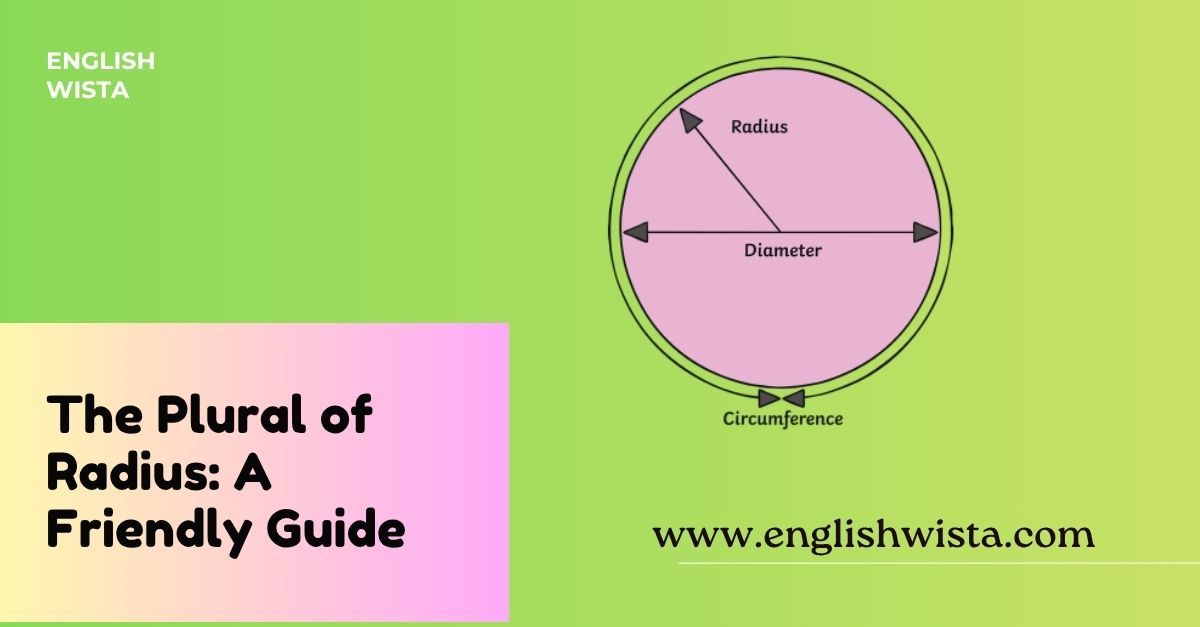Have you ever been in a math or science class and suddenly wondered, “Wait, what’s the plural of radius?” You’re not alone! Words like this can feel a little tricky because they don’t always follow the simple add-an-“s” rule that most English words do. Instead, radius belongs to a special group of words that come from Latin, and their plurals sometimes look a little different.
Don’t worry we’ll make this simple. By the end of this article, you’ll know exactly how to use the plural of radius, how to say it, and even how to use it in real-life sentences. Along the way, we’ll explore fun facts, examples, and little tips to make sure you’ll never hesitate when writing or speaking.
So, let’s dive right in!
What is the plural of radius?
The plural of radius is radii.
That’s the traditional, classical form taken from Latin. However, in modern English, especially outside of formal writing or math-related discussions, you’ll also see people use radiuses. Both are correct, but radii is preferred in scientific, technical, or mathematical contexts.
- Radius = singular (one)
- Radii = plural (more than one, traditional form)
- Radiuses = plural (accepted modern form)
For example:
- “The radius of this circle is 5 cm.”
- “The two radii of the circles are equal.”
- “The software lets you adjust different radiuses of curved shapes.”
Why does “radius” have two plural forms?
This is where English gets fun (and sometimes confusing). English has borrowed a lot of words from Latin and Greek. When we borrow words, sometimes we keep the original plural endings, and sometimes we adapt them to regular English rules.
- From Latin: radius → radii
- In English: radius → radiuses
Think of it this way: if you’re talking with friends, “radiuses” might feel more natural. If you’re writing a math paper or working in a technical field, “radii” will look more polished.
Is “radii” pronounced differently?
Yes, it is! Many learners get nervous about pronouncing radii, but it’s easier than it looks.
- Radii is pronounced like ray-dee-eye.
- Radiuses is pronounced just as it looks: ray-dee-us-iz.
So, when reading aloud, you’ll hear the difference clearly.
What does “radius” mean?
Before we go further, let’s quickly define radius.
In simple terms, radius is the distance from the center of a circle (or sphere) to its edge. If you imagine a pizza, the radius is like the line from the middle of the pizza to the crust.
In math, it’s often used in formulas like:
- Area of a circle = πr² (where r is the radius)
- Circumference of a circle = 2πr
So, when you have more than one circle or sphere, you might need to talk about several radii or radiuses.
Real-life examples using “radius” and “radii”
Let’s make this practical with real sentences you might hear:
- “The doctor measured the radius of the tumor using a scan.”
- “The engineer compared the radii of two different pipes.”
- “We adjusted the radiuses of the curved corners in the design software.”
- “In geometry, all radii of a circle are equal.”
- “The game lets you change the blast radius of a weapon.”
Notice how in technical or scientific contexts, radii pops up more often, while in casual speech, radiuses sounds more natural.
Does the word radius have other uses?
Yes! While radius is most often used in math and science, it also has everyday uses.
It can mean:
- A line from the center of a circle to its edge (the math meaning).
- The distance from a central point to the outer edge of an area.
For example:
- “The hotel is within a five-mile radius of the airport.”
- “The explosion destroyed everything in a two-mile radius.”
Here, radius describes a range or distance around a point, not just geometry. And when you need more than one, you’d say radii or radiuses, depending on your audience.
Comparing with similar words
Sometimes it helps to compare with other Latin-derived words that behave the same way.
- Nucleus → nuclei (or nucleuses)
- Focus → foci (or focuses)
- Cactus → cacti (or cactuses)
- Syllabus → syllabi (or syllabuses)
See the pattern? English allows both the original Latin plural (ending in -i) and the Anglicized plural (ending in -es). That’s why radius can become radii or radiuses.
Common mistakes people make
When learning the plural of radius, some people get tripped up. Here are a few common mistakes to avoid:
- Adding only “s” → “radiuss” (❌ incorrect)
- Mixing Latin and English endings → “radiuseses” (❌ very incorrect)
- Using radius as plural: “Three radius are equal.” (❌ wrong)
The correct forms are:
- Singular: radius
- Plural: radii or radiuses
Fun facts about the word radius
Let’s sprinkle in some interesting trivia!
- Origin: The word comes from Latin, meaning “staff” or “spoke of a wheel.” Think of a wheel’s spoke stretching from the center to the edge that’s basically a radius.
- Anatomy use: Did you know there’s also a bone in your arm called the radius? It runs from your elbow to your thumb. And yes, when talking about both arms, you’d say radii (though in anatomy, “radius bones” is also used).
- Everyday English: The word is often used to describe “range” or “coverage.” For instance, “Wi-Fi radius” or “travel radius.”
How to remember the plural easily
Here are a few tricks:
- Think math = radii
If you’re in a math or science context, go with radii. - Think casual English = radiuses
If you’re chatting or writing casually, radiuses will feel natural. - Memory trick
Imagine the “i” in radii as tiny circles lined up in a row. Since circles have radii, it’s easy to connect!
Practice with examples
Let’s practice together. Which plural fits best?
- The geometry teacher drew three ______ on the board.
- Correct: radii
- The designer changed the corner ______ of the table in the software.
- Correct: radiuses
- All the ______ of the circle are the same length.
- Correct: radii
By practicing like this, you’ll start to remember naturally.
Quick recap
- Radius = singular.
- Radii = traditional plural, mostly for math, science, and formal contexts.
- Radiuses = modern plural, often used in casual or everyday English.
- Both forms are correct, but the choice depends on the situation.
Conclusion
So, what’s the plural of radius? You now know the answer: it can be radii or radiuses, depending on the setting. If you’re in a classroom, working on geometry, or reading a science article, you’ll probably see radii. But if you’re in everyday conversation, “radiuses” works just fine too.
The key takeaway is this: both forms are correct, so don’t be afraid to use them. Just choose the one that fits your audience best. And now, the next time someone hesitates over the plural of radius, you’ll have the answer ready no second-guessing needed.
Language can be quirky, but that’s what makes it fun. So, whether you’re talking about the radius of a pizza, the radii of multiple circles, or the radiuses of curved designs, you can feel confident in your choice.



